Piyaphon Inthavong (0337589)
Game Studies
Projects
INSTRUCTIONS
TABLETOP PROJECT
Week 1 | Tabletop Game Brief
This week, Mr. Charles briefed us through the main projects and phases which will take place in this game studies module. The main objective of the projects is to create a playable virtual board game in the Tabletop Simulator (due to the MCO regulations, physical board game was canceled, so we decided to utilize Tabletop Simulator from steam as the main tool of the board game project for the Game Studies module.We were divided into groups of 2 and I paired up with Kenny via a random lot pick. We started off getting to know each other, familiarised our board games background and knowledge, and quickly aligned our first idea on project 1. The idea was initially from a board game called Tickets to Ride.
 |
| Figure 1.1. Ticket to Ride, a four player board game for reference. |
 |
| Figure 1.2. Ticket to Ride board, cards and game assets. |
 |
| Figure 1.3. A rough visual reference for the board game. |
Week 2 | Tabletop Game Proposal 1
For the tabletop game project, I was grouped with Kenny. Throughout the second week, we shared our board game experience, knowledge and came up with the first idea on the game "The Conquest of the Kingdom." The game features the genre of board game strategy where luck is not the only contribution in winning the game which is common among board games using dice as the main instrument. We worked together on the game rules and sketched the first draft on how the game will look like. |
| Figure 2.1. Phase 1: Identifying game locations for each players. |
 |
| Figure 2.2. Game Draft 1: Four Kingdoms are placed on the edges of the board. |
 |
| Figure 2.3. Final Game Draft: The game set its beginning from the corners and slowly progresses to the center as the territory level also increases. |
 |
| Figure 2.4. The first point system. These are the success measurement of the game as players with the highest points are the winners. To earn points, players have to conquer territories. |
It was an enjoyable session getting to know Kenny more of a friend and not only classmate.
After showing the first proposal and draft to Mr. Charles, we received his feedback to be more specific with the description of the games. The make little twitch on the rules of the game because it was confusing to many people. He also asked us to create variations and think of more ways to implement the same concept to the game. That being said, he was glad to see quick progress from us and looked forward to the first game test the next coming practical session.
 |
| Figure 2.5. Week 2 summary. |
Week 3 | Tabletop Game Fix
Kenny and I gathered up again and worked on the feedback that was given earlier by Mr. Charles. We tackled each problem slowly to make sure they are properly addressed and did a playtest together. Major changes were made after the playtest. |
| Figure 3.1. Week 3 summary. |
Detailed updates:
- Game description was added. Dicing rules was clarified.
- Complicated math/point system was simplified using the new game instrument (cards). As a consequence, the core rules also changed to accommodate the update. With point system eliminated, maths are no longer part of the equation.
Core game mechanics update log (version 2.0):
- New game instruments added: cards and coins. The game no longer depends solely on dices.
- Cards act as the record of a player's territory. They are labeled accordingly to the level of the territory (ex. 1, 2, 3, 4..), which resulted in a removal of the 3 digits point system. Players will compare the cards they have at the end of the game to measure who has the most points added from the cards they collected.
- Removed the "moving cost," where players no longer have to waste time counting each move. The consequences of failing to roll certain numbers of dice to move are no longer harsh, which previously has known to make the player feel agitated.
- Reworked Secret Tunnels: it's now a public property that no kingdoms can own. No points will be granted for moving there. The secret tunnel now allows the player to move to level 4 right away.
- Reworked Lucky Shrine: The player will have to flip a coin; Heads will grant the player a "Triple Dice" ability for a single-use. Whereas getting tails means losing a turn.
- To give the game more identity, we named each kingdom and gave them colors. Emblems are also designed for each Kingdom.
 |
| Figure 3.3. A ready-to-play game setup on Tabletop Simulator (v2.0). |
Week 4 | Game Test 1 (Version 2.0)
This week we fully prepared our version 2 of the board game (The Dragon Expeditions) into the Tabletop Simulator with the graphically designed game maps, player emblems, cards, flags, and all appropriate tools setup.The result from the gameplay was unexpected, there were lots for us to improve on, and players didn't seem too engage with the game either. Mr. Charles analyzed the game and pinpoint most of the weaknesses and gaps which was obvious to the game. Most of the feedback was mainly on balancing the game mechanics and to improve the way to increase the engagement or "hook" to the players of the game as the beginning of the game was already too difficult. The feedbacks are summarised in the notes below:
 |
| Figure 4.1. Feedback from game test 1. |
After the session, Kenny and I gathered to analyze the feedback and identify the roots of the problems which was mainly involving the game mechanics. In response to the feedback, we decided to make a huge gameplay fix and update (that means turning the game into the third version). We identified a new solution in response to the over reliance on the luck from the dice. As a strategy game, we want to prevent too much luck from being involved, so we eliminated the mechanics on throwing the dice every turn and implemented a new core obstacle, the rivers. Details are further discussed in week 5 meetings.
As a result of the long hours of brainstorming, we finally implemented the third version of the game, which changes the main gameplay. The updates are listed below:
There were a lot to digest from the feedback on the game test of version 3.1, but as usual, we start by identifying the main problems from the previous game test and worked on the highest priority tasks first. In this case, we carefully planned where to place certain lands (level 1 to level 3) so that it is more balanced for the gameplay.
Added Dice Indications
We added dice pictures on the neutral land beside the red shrine and nearby it for players to cross the river more systematically. To travel back to the homeland (I'm referring to the lands on the left and right side), players can simply move to the neutral land with an arrow icon. The dices were also added to the secret cave to indicate and emphasise on the passive ability that it offers (the dice requirement reduction).
Connected Arena Region (center region)
Previously it was almost impossible to have interactions with other players when it comes to the arena region of the map as 4 sides are separated with river. To solve the issue, we added neutral lands to connect the lands horizontally, leaving the vertical center region disconnected to give the Boat magic card a relevance in the game. If we were to connect every land together then the boat no longer have its position in the game.
We spent the entire evening on the 3rd game test today with Mr. Charles, Abby, Ryan, Kenny and myself. It was a fair update from the previous version (v 3.1) as we introduced coin systems, with an upgraded table setup for better user experience.
Upon many compliments from the previous game test, we both realized the game is getting closer to being playable, so we worked on a few aspects of the game for improvements:
It was one of the most unexpected class in the Game Studies module as Mr. Charles has invited a board game expert to provide insightful thoughts and responses for our current board games. In a short play test session, Mr. Jian quickly spotted a number of weaknesses in the game that causes the lack of player interaction in the main gameplay. To summarise his feedback, I have written the pain points in key words and also included the solutions in which Kenny and I have discussed shortly after the play test (refer to figure 12.1).
We certainly received lots of critiques and feedback from the previous week and aimed to fix each problems one by one. We first brainstormed the problems the pain points in key points as seen in figure 12.1 (in the previous week), and went straight to a collaborative platform to plan the new map together. In the following photo (figure 13.1), both Kenny and I planned through many possible scenarios starting from subversion one to five. We met up for a total of 2 days and finally announced the version 5.0 of the game to be worked on for the next play test.
It was heavy planning for a huge change to the fifth version of the game. We had to sacrificed the strongest element of the game and fully rebalance everything. Please refer the following key points to figure 13.2:
It was a long night as the game almost lasted 2 hours. The players picked up the rules of the game quickly and start planning their moves without much guidance. It was a huge thank to the land card that explained each levels and land of the game in only a quick glance. The players loved the item shop concept and enjoyed throwing spells at each other. The Gold Mine was one of the most popular element in the game despite being newly implemented in the update.
The game feedback from the previous week was extremely positive compared to the game test 4 in week 12. Although there were few points that we wanted to improve on. The main changes in version 6.0 are listed in the following points:
In this final game update, Kenny and I worked on a few problems that Mr. Charles found during the final game test. First, we updated the benefits of the underused element, which is the Secret Tunnel and the Gateway Tunnel. Valuable lands (or high-level lands) are now located near these elements to increase the value and player interaction in these areas.
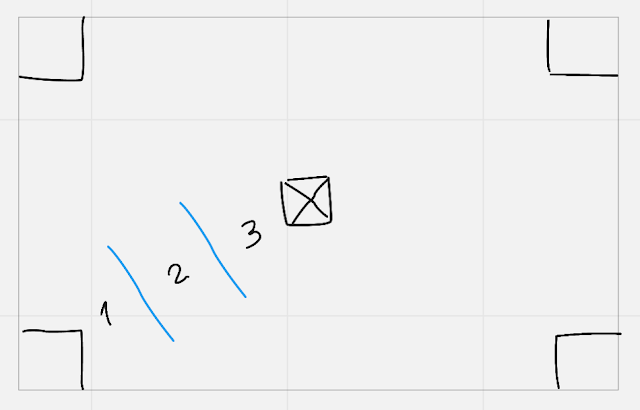 |
| Figure 4.2. Adding rivers as the main level crossing mechanics. |
 |
| Figure 4.3. Draft 1: game map (version 3.0). S refers to Secret Cave. T's for Lucky Shrine (initially towers). |
 |
| Figure 4.4. Draft 2: game map (version 3.0). |
 |
| Figure 4.5. Card designs for game v2. |
Week 5 | Game Update (Version 3.0)
It was the longest session so far with Kenny this week. We discussed almost all the possibilities and directions the game could lead to spent hours brainstorming different possible narrations and ideas on the core mechanics of the game. Below is the summarised work status of week 5: |
| Figure 5.1. Week 5 update summary. |
 |
| Figure 5.2. Artifacts planning. Artifacts refer to the special levels of the game. |
 |
| Figure 5.3. Defining winning criteria and identifying different game directions. |
 |
| Figure 5.4. Planning game narration. |
 |
| Figure 5.5. Planning game settings. |
As a result of the long hours of brainstorming, we finally implemented the third version of the game, which changes the main gameplay. The updates are listed below:
Core game mechanics update log (version 3.0):
- Moving no longer require dice, instead "rivers" were added as an obstacle for players to reach the next level (ex. level 1 to level 2).
- Rivers now requires the player to roll the dice above a certain number to be able to cross it with a bridge.
- The game map is expanded; More lands of each level are added.
- Reworked lucky shrine and a secret tunnel. The tunnel provides a safer path to level 3 from level 2 (requires lesser dice roll number). The lucky shrine now offers Power Cards (details are yet to be discussed).
- Added narration or story to the game. In short, 4 Kingdoms seeks to become the best by conquering lands with valuable resources (indicated by the land levels).
 |
| Figure 5.6. Final map draft guideline of game version 3.0. |
Week 6 | Game Test 2 (Version 3.0)
As the game was massively changed from the previous week, we had another class gameplay test session in today's practical session. A few hours were spent on the gameplay, and it gathered lots of positive feedback from each player, including from Mr. Charles. However, since the gameplay updates jumped heavily on its first sub-version, there were lots of potentials and gameplay update ideas to work on. To sum it up, I noted everything below: |
| Figure 6.4. Game test v3: Artifacts feedback. |
"To sum it up, the gameplay is getting there but u gotta think about connecting the dots better and giving the sense of empowerment of the characters."
Week 7-8 | Game Update (Version 3.1)
Upon receiving lots of constructive feedback from Mr. Charles, Kenny, and I spent almost a week analyzing the huge chunks of information into key points and gradually tackling each. We took Mr. Charles' advice on not overdoing things and kept the board game map the same way to not over change the game movements and its mechanics. However, a few tweaks were made as a response to the feedback.
Optimized Game Play Area & Game Pace
The gameplay area was planned to be reduced from the first 5 moves of the game to increase the game pace, hence allowing each player to reach their first point of interaction earlier than the previous version (v 3.0). Each player are now given a power card from the beginning in order to introduce their understanding of the power cards in the early phase of the game before reaching much more complex and powerful cards. The level 3 lands are expanded to increase the choices of conquering and play area.
Increased Player Empowerment
To address the sense of empowerment to the player of the game, more variety of power cards are produced to increase the game flexibility and again, faster phase of the interaction. Such power cards now allow players to jump from a place to another in one turn, allowing a sense of dynamic movement and flexibility to the game.
Buffed Artifacts
This aspect has gained its popularity since the previous version of the game, which also resulted in a higher feedback level to the artifacts. To address its "passiveness" and its uses, the Secret Cave/Tunnel and the Lucky Shrine now gains a passive ability when a player stands on them. Taking Mr. Charles' teleportation suggestion into consideration, the functions of the artifacts are balanced as follows:
- The Secret Cave now passively provides a -2 reduction to cross the river to the 3rd level. A neutral ground was also added as a path that prevents an "unfair" blockage to the cave (this is seen in the previous game test as a player was blocked out of their way to the cave). The Cave now grants teleportation ability to certain portals of the map. This is for the purpose of increasing the game dynamic and strategy. The Cave no longer provides power cards.
- The Lucky Shrine now provides immunity from most of the spells. It's importance is increased from the improved variety of power cards. A new type of shrine is added to the game as both shrines are now considered either an Offensive Shrine or Defensive Shrine. Each shrine allows the player to draw power cards from different decks (offensive power cards and defensive power cards).
Week 9 | Game Update (Version 3.2)
Added Dice Indications
We added dice pictures on the neutral land beside the red shrine and nearby it for players to cross the river more systematically. To travel back to the homeland (I'm referring to the lands on the left and right side), players can simply move to the neutral land with an arrow icon. The dices were also added to the secret cave to indicate and emphasise on the passive ability that it offers (the dice requirement reduction).
Connected Arena Region (center region)
Previously it was almost impossible to have interactions with other players when it comes to the arena region of the map as 4 sides are separated with river. To solve the issue, we added neutral lands to connect the lands horizontally, leaving the vertical center region disconnected to give the Boat magic card a relevance in the game. If we were to connect every land together then the boat no longer have its position in the game.
Week 10 | Game Test 3 (Version 3.2)
General feedback: Clarify the rules, and make it clearer for new players. Write a quick summary of what the game is about.
Pros: "Overall the game is much more fluid, much more action, and functions are available for play. Well done for the offensive and defensive cards. The gameplay is much more refined. I like the dynamic features that the game offers. The game features an adjacent tile, the cave teleport to big distances, there are coins to buy cards of your own choice whether its an offensive or defensive."
Cons: "On the other hand, I don't necessarily like the blank card even though it's a little biased, it's too merciless. The center (Dragon Land) is missing a feature that lacks a sense of empowerment despite being the strongest land in the game."
"In the end, I must say, I want to play this game again if I get a chance to do so." - Mr. Charles
It's now time to work on the visual design of the board game. Mr. Charles told us that he sees the graphical theme of the board game as a medieval fantasy art style, which perfectly suits my team's intention that we have thought about from the beginning. That said, Kenny and I planned to carry on the visual design in that manner.
Week 11 | Game Update (Version 4.0)
- Blank cards are now removed from the game.
- Portals are now interconnected with the homeland region (it was previously pointing out to the river in the game version 3.2).
- The lands on both the homeland and arena region were rebalanced and recalculated according to the total amount of points accumulated from each level.
- Neutral grounds are now added to the arena region (center) of the map as some players were stuck in that region in the previous game test (v 3.2) for many turns, resulting in an unpleasant experience. That said, players can now travel across the area region without the concern of being blocked by different lands.
- The powerful quadruple lands on the center of the map are now expressed visually via the magic aura from the Dragon Land. Those are the region that gives authority to the players to make an attempt to settle/fight for the land.
- Lastly, the river system is now systemically implemented. Players are only allowed to cross rivers on certain lands with a picture of dices on it.
Week 12 | Game test 4 (Version 4.0)
Week 13 | Game update (Version 5.0)
- The boat element is now systemised with the Dock which is shown in orange. The Dock is a specific path for the boat to travel, which means the boats are no longer usable anywhere in the map. The change is further illustrated as a deadly ocean with sharks that is not safe for travel.
- A new core element is added to the game, that is the Gold Mine. The Gold Mine plays a crucial role in the game by increasing the income of each player by 1 gold coin per turn when it is conquered by a kingdom.
- Item shops are added with newly designed magic cards exclusively for the item shop. The item shop panel is now added to the left side of the map for the convenience of the players. The left panel also includes the Magic Shrines' cards, discard pile, and used cards. These are all the problems mentioned in the previous play test.
- The map is expanded with more lands for players to play on.
- Small rivers in the center island is now removed to increase player interaction.
- Dragon levels no longer exist in the game. It is replaced by the Central Portal, which is located right in the center of the map. The Central Portal is the main entrance from the Secret Portal.
- Rebalanced Secret Portal: The portal now offers teleportation to every portal in the game, these are lands illustrated in purple.
- The magic shrines deck can now be bought with the cost of 5 gold coins.
Week 14 | Game Test (Version 5.0)
After a huge change from version 4 to 5, we knew we were ready for the next play test so I invited a few acquaintances of mine from different schools and countries for a huge game test night. It was one of the most unexpected gatherings, but as the game started, it became a casual night for everyone to enjoy together.
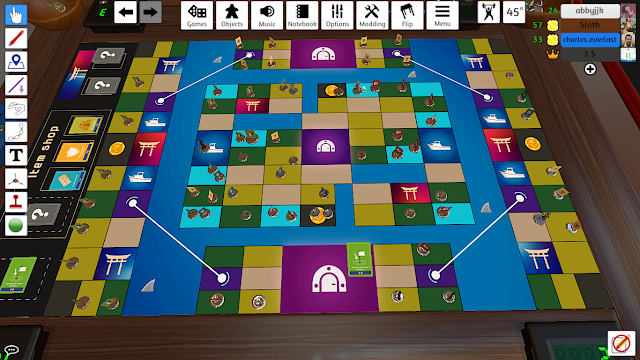 |
| Figure 14.2. Results of Game Test 5. |
"The concept of the game is cool. It's like a fusion of Monopoly and Card Wars and I really enjoyed playing it." -Arthy
Week 15 | Game Update (Version 6.0)
- Game map is rendered with texture.
- Improved color scheme.
- Additional new game logo.
- The boat pass card is removed, and is instead replaced with 3 coins ticket.
- Game cards are designed with new color schemes.
- New cards are implemented to the game: The teleport card, charge card, gold, and reflect card. Each card is exclusive in specific decks in the game.
- The costs of the cards are rebalanced.
Week 15 | Final Game Test (Version 6.0)
Its the final game test week with Mr. Charles. After long weeks of a few game updates, we finally had the chance to meet him again for the final gameplay. We presented him with our 6th version of the game, and to our surprise, everyone enjoyed the version of the gameplay as we received many generous compliments this session.
 |
| Figure 15.1. Beginning of the game test 6 (v6.0). |
 |
| Figure 15.2. Mid of the game test 6 (v6.0). |
 |
| Figure 15.3. Results of the game test 6 (v6.0). |
The final play test went smoothly, although Mr. Charles asked everyone to have their final update ready soon for submission with his final feedback to the game.
 |
| Figure 15.4. Feedback note on the final game test. |
"It's very a much more exciting game, with more action-packed. The new features you guys added really worked and they were very interesting to the whole dynamic of the gameplay." -Mr. Charles
Final Game Update (Version 6.2)
 |
| Figure 15.5. Final Game Map on version 6.2. |
 |
| Figure 15.6. Final offensive cards. |
 |
| Figure 15.7. Final defensive cards. |
 |
| Figure 15.8. Final item shop cards |
Final Game Design Document
Link to the final game design document
Final PDF Embedded Game Design Document

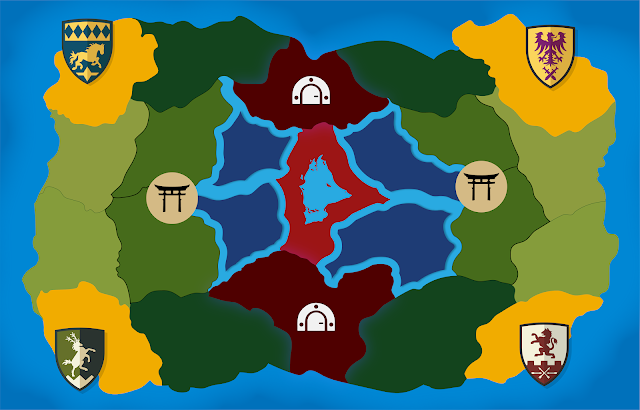
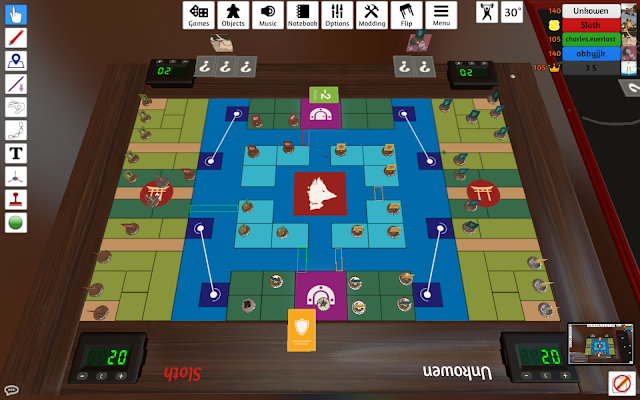





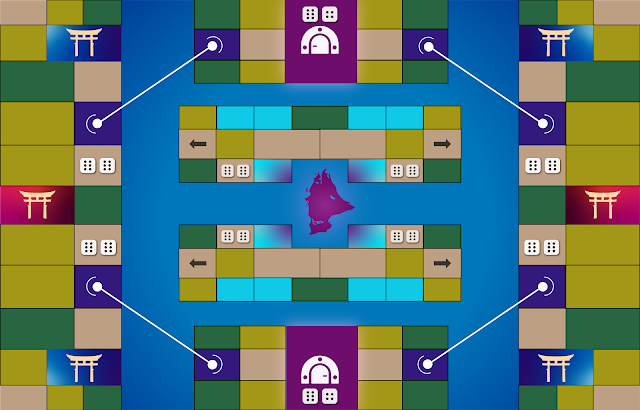









Comments
Post a Comment